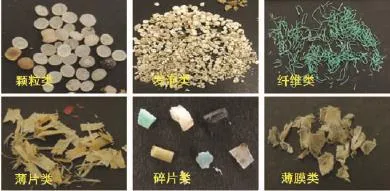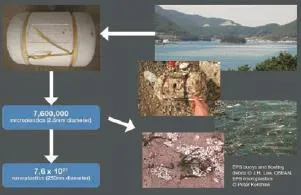重视海岸及海洋微塑料污染加强防治科技监管研究工作∗
2016-03-27章海波晨1骆永明
章海波 周 倩 周 阳 涂 晨1 骆永明
1 中国科学院烟台海岸带研究所 烟台 264003 2 中国科学院大学 北京 100049
重视海岸及海洋微塑料污染加强防治科技监管研究工作∗
章海波1,2周 倩1,2周 阳1,2涂 晨1骆永明1,2
1 中国科学院烟台海岸带研究所 烟台 264003 2 中国科学院大学 北京 100049

海岸带及海洋环境中的微塑料污染已经成为全球环境问题。我国已对一些典型河口、海湾、海岛周边海域及潮滩开展了微塑料污染的初步调查,积累了一些基础数据。但目前从基础理论、方法学及评估与控制技术等方面都远未达到环境监管的要求。因此,需要从建立和完善微塑料调查、监测与评估的方法学体系,厘清我国海洋微塑料的排放格局与污染分布规律,建立微塑料及其附着污染物的毒理学评价指标体系与参数库,形成海洋及海岸环境微塑料污染控制与管理技术体系等角度开展全面系统研究,解决现有的技术难点和关键科学问题,为我国海岸及海洋环境微塑料污染的监管与安全保障提供科学支撑。
微塑料,近岸海域,研究方向,管理策略
DOI 10.16418/j.issn.1000-3045.2016.10.007
海洋及海岸带环境中的塑料污染已经成为全球性污染问题,预计至 2025 年,全球海洋中塑料垃圾量将高达 2.5 亿吨,即每 3 吨鱼中,就有 1 吨塑料;而中国被认为对全球海洋塑料垃圾的贡献高达 27.7%[1]。国家海洋局的调查也显示,我国 37 个海域的海面漂浮垃圾和海滩垃圾中,塑料类占 77%,并且 86%—91% 来自陆地①国家海洋局.《2014年中国海洋环境质量公报》. http://www.coi.gov.cn/gongbao/nrhuanjing /nr2014/2015 03/ t20150316_32225.html。这些残留在环境中的塑料垃圾经过长期风化裂解形成小于 5 mm 或 1 mm 甚至纳米级的微塑料。Eriksen 等人[2]统计全球海洋中微塑料碎片(< 4.75 mm)高达 4.85 万亿个,合计重量达 3.54 万吨。但最近英国科研人员认为海洋中的微塑料碎片量更高,为 15万亿—51 万亿个,合计总量在 9.3万—23.6 万吨之间[3]。海洋环境中的微塑料一方面通过自身生物吞噬作用对浮游动物和底栖生物产生危害;另一方面通过表面富集重金属、持久性有机污染物(POPs)、新型高毒有机污染物等,作为污染物载体给海洋及海岸带生态环境带来严重危害[4-7]。因此,海洋及海岸带微塑料污染成为近年来全球范围一个新的研究热点[4,8,9]。
1 我国海洋及海岸环境中微塑料污染的调查研究与基础数据积累
从目前公开的文献检索发现,我国最早关注海岸带微塑料污染的是香港大学的研究人员。他们从 2008 年开始对香港地区的 9 个海滩进行了调查,分析了颗粒类塑料表面的 POPs 污染情况[10]。2014 年,华东师范大学报道了长江口及其附近海域漂浮微塑料的污染情况,成为中国大陆地区第一例海岸带微塑料污染的调查案例[11]。近两年来,华东师范大学、中科院烟台海岸带所、香港大学、香港教育学院等研究单位相继开展了一些探索性工作,初步积累了一些基础数据。调查区域从北到南包括:渤海湾地区的大连和曹妃甸、山东半岛、长江口、瓯江口、椒江口、闽江口、珠江口和香港地区、广西北部湾、海南岛等区域[11-16]。调查区类型涵盖主要河口及附近海域、自然潮滩、海滨浴场沙滩、养殖区、小渔港等。调查包括水体、潮滩土壤与沉积物、泥沙等;个别调查涉及了双壳类动物体内的微塑料污染[17]及食用海盐中的微塑料污染情况[18]。
根据现有的调查结果来看,我国海岸带邻近海域已普遍受到微塑料污染,并且在类型上有一些本土化特征。(1)在丰度上,河口水面漂浮微塑料丰度相对较大,如长江口水面漂浮的微塑料可高达 10 200 个/m3, 而远离河口的丰度要小若干数量级[11];滨海沙滩和潮滩上的微塑料丰度可高达 258 408 个/m2[13],一些养殖区附近潮滩的微塑料丰度相对较高;总体上,我国海岸带及近海中的微塑料污染丰度高于其他研究区[4]。(2)微塑料形状多样化,包括泡沫、颗粒、碎片、纤维、薄膜等类型,颜色多彩化,红、白、蓝、绿、黑、紫、棕、青等(图 1);在大小上以 <2 mm 或 <1 mm 为主,如闽江口、椒江口和瓯江口漂浮微塑料中 0.5—2 mm 粒径范围占70% 以上[15]。(3)表面微观形貌多呈不规则、裂痕、缝隙等状态,携带原油、硅酸盐粘土矿物、铁氧化物,同时也检测到 POPs 类污染物等[10,16]。(4)聚苯乙烯发泡类微塑料污染在我国海岸带地区非常普遍,聚乙烯树脂颗粒类在局部点位也会聚集,一些样点存在多种类型、不同形状和颗粒大小的微塑料颗粒同时出现的情况。

图1 环境中不同类型的微塑料
但总体上,我国的海洋微塑料调查和研究才刚起步,对全国海岸带及其邻近海域的微塑料污染现状尚不清楚,包括微塑料类型、大小、时空分布、来源和归趋及生态风险等。研究力量薄弱,研究人员背景以海洋科学、环境科学为主,缺乏多目标、多学科的交叉与协同。此外,公众和管理部门对微塑料污染也还普遍缺乏认识,这也与相关基础研究和数据积累少,缺乏有效的科技支撑有关。
2 我国海洋及海岸环境中微塑料污染的监管需求、差距及关键科学问题
我国沿海地区微塑料污染负荷高[1],并且具有丰度大、类型复杂多样等特点。而大量的微塑料污染及携带的毒害化学污染物质可能对我国近海渔业资源和生态系统造成危害[17]。因此,加强我国海洋及海岸环境中微塑料污染的监管是保护我国渔业资源和滨海生态环境,服务国家海洋环境外交的必然要求。
2.1 海洋及海岸环境中微塑料污染的监管需求与差距分析
2.1.1 监测技术与方法
海洋及海岸环境微塑料的监测包括采样、分选、鉴定、分析等内容。监测的对象包括海水表面、不同水层、土壤/沉积物、浮游动物和底栖生物等。不同对象的监测方法有很大区别,如:水体表面采样通常用漂浮生物网、不同水层采用浮游动物网进行采样;分选上,水样可以采用直接过滤或结合浮选的方法;土壤/沉积物需要筛分-浮选相结合;生物样品还需要做消解预处理等[19,20]。鉴定和分析的目的是要识别微塑料类型、物质成份、宏观和微观形貌特征、丰度、粒径等一系列特征指标,因此通常会使用红外或拉曼光谱、热重/差热分析、扫描电镜-能谱法、裂解气相色谱-质谱法等现代分析手段[21]。
但是,结合文献调研和实际研究情况可以发现,当前在海洋和海岸环境微塑料监测中仍存在以下关键问题。(1)采样、分选方法缺乏规范与标准,随意性较大。如,采样位置及面积、深度、采样量、拖网速度、网孔/网口大小等参数都缺乏统一标准;分选程序及装置设计也缺乏规范与指南。(2)浮选、分离及测量方法效率低下,无法满足大范围、大样本量的调查与常规监测;需要加强高效、便捷、廉价、安全的技术方法研发。(3)调查结果的表征缺乏规范,如:对微塑料类型的分类有采用颜色、形状、成份等不同标准,含量和丰度的计量单位也缺乏一致性。(4)生物体中微塑料积累的监测技术和方法非常欠缺。
2.1.2 微塑料污染的评价标准
评价标准的制定是以基准为基础,基准的推导则需要综合考虑污染负荷、生态毒理临界值(EC50,EC20,NOEC 等)、环境承载能力等关键参数。但是,国内外对海洋及海岸环境中微塑料的基准及其相关研究都还相当缺乏:(1)缺乏基础调查数据积累,目前基于相关模型估算和局部调查的结果对区域环境监管缺乏针对性和指导性。(2)缺少制定标准所必需的生态毒理学评价指标及其阈值;尽管国外已有报道认为,微塑料可以进入生物体内并产生毒害作用,并且微塑料携带的持久性有机污染物等化学物质也可以在生物体内积累、放大并污染食物链等[22-24],但目前仍然无法提出针对微塑料污染的敏感指标及其阈值;同时,微塑料表面由于复杂结构和形貌特征,通常会成为 POPs 等毒害污染物的载体,进而形成复合污染物,对生态系统的危害变得更为复杂[5,16,25]。(3)由于缺乏污染负荷以及微塑料的生态效应评价参数及其阈值,因此无法预测基于生态系统保护的近海与海岸环境中的微塑料污染的环境承载能力。
2.1.3 来源与归趋分析
科学评估海洋及海岸环境中微塑料的来源与归趋可为提出有效的源头控制措施,预测微塑料的积累和污染热点区提供依据,进行靶向控制。目前对全球海洋中塑料垃圾的来源估计中普遍认为陆源占 80%,海源占 20%[1,12]。但对微塑料来源分配估计目前尚无明确的清单。根据文献报道[8,9,26,27],海洋中的微塑料来源可归纳为三类。(1)陆地河流及排污系统输入,比如洗涤剂、生活护肤以及工业原料等中的微塑料成份;由于其粒径小、密度低等原因,不易从污水中分离或去除,从而随污水排出进入环境中。(2)环境中尤其是海滩上塑料垃圾的长期风化裂解形成微塑料甚至纳米级微塑料;比如一些休闲旅游沙滩、养殖海滩、码头等残留的大量塑料垃圾,在长期受高温、紫外辐射裂解后形成微塑料,并通过风力或潮汐等作用带入海域中(图 2)。(3)捕鱼、船舶运输、海上油井平台中的微塑料直接输入或塑料垃圾倾倒后风化分解形成微塑料;根据联合国环境规划署(UNEP)2005 年估算,全球船舶运输中输入到海洋的塑料垃圾在 500 万吨左右[28];此外,运输过程中泄漏或工厂加工过程中直接排放导致的树脂颗粒污染是海洋及海岸环境中微塑料污染的一种重要类型,这些作为工业原料的树脂颗粒不仅出现在工业区附近海域,也出现在一些没有相关工业活动的海岛附近海域[29]。

图2 水产养殖中泡沫塑料浮子的风化与微塑料的形成[30]
有关微塑料的归趋问题,Eriksen 等人[2]认为大洋表面水体不完全是漂浮微塑料的库。Van Cauwenberghe等人[31]在 1 100—5 000 m 的深海大洋底部表层沉积物中发现微塑料存在,表明微塑料可以从海水表面向下沉降至大洋深部,但其沉降机制仍不清楚。同时,海面漂浮微塑料可能在风力、洋流、潮汐等共同作用下在潮滩和海湾截留。如:在一些远离人类活动的海岛自然保护区潮滩[32],以及人迹稀少、几乎没有工业活动的近岸海域都发现微塑料污染,并且有些地区的丰度可高达到 9 200 个/m2[33]。此外,动物吞食[34,35]、生物降解[36]等也被认为是海面微塑料去除的重要机制。
2.2 海洋及海岸环境中微塑料污染研究的关键科学问题和技术难点
微塑料作为海洋及海岸环境中的一类新型污染物,当前国内外的研究还都处于起步阶段。因此,不仅在调查、监测等基本的方法学上还未形成统一的技术规范,而且在海洋及海岸带环境中的来源、分布及归趋上也还存在许多尚未解决的科学问题,对微塑料的生态环境效应更是缺少毒理学数据支撑,具体包括以下四个方面。
2.2.1 微塑料的调查与监测分析技术
在采样方面,如何确定采样范围、深度,并设置科学合理的样方和样带,使采集的微塑料样品具有代表性,不同的调查结果也具有可比性。现有的采样(拖网孔径较大)和分选方法(肉眼分选)导致小粒径(如<100 μm)的微塑料无法被收集,从而使对微塑料的研究难以向更小粒径发展。因此,如何研发包括更细颗粒的微塑料采样、分选和监测方法是亟待解决的关键技术难点。在检测分析方法上,除微塑料自身外,还包括塑料中添加可在一定环境条件下溶出的化学物质(如,酞酸酯、PBDE、双酚 A 等),以及表面吸附结合的环境污染物(如,PCBs、DDE、PFOA 等);这些污染物也是微塑料研究中需要重点关注的对象。因此,如何针对这些污染物,建立微塑料的采样、分选与检测方法,也是微塑料监测分析中需要解决的关键技术难点。2.2.2 海域中微塑料的生物地理学、生物地球化学及预测
目前对海洋环境中微塑料的归趋主要存在风动力及水动力条件下的海滩与海湾截留机制、生物淤积机制、动物吞食机制、生物降解机制等理论假设;总体上是受到海岸地理特征、海洋及海岸带生物活动、化学及动力学过程等综合因素影响的结果。因此,如何利用多学科交叉的优势从生物地理学、生物地球化学以及河口海岸水动力学等多角度阐释微塑料在河口、海湾、海岛周边海域及海滩的微塑料分布规律,以及在垂直水体中的转化迁移机制是目前研究海洋微塑料归趋需要解决的关键科学问题;同时,也要结合微塑料的来源与负荷分布特征以及海洋环境中的塑料风化分解特征,建立不同海域微塑料的动态消长预测模型。
2.2.3 海域中微塑料及其附着污染物的生态毒理学指标与基准
目前有限的调查和模拟结果均证实微塑料可以进入部分海洋生物体内,但对微塑料及其附着的污染物在海洋生物体内的分布与毒理学机制还缺乏系统认识。因此,结合海洋生物对微塑料的吞食过程及其在食物网中的传递、转化或富集,阐明微塑料自身及其附着污染物的生物毒性效应与机制,并筛选微塑料污染的生物体敏感指标(包括致死率、发病率、繁殖率等)和生物标志物,建立剂量—效应关系,是微塑料生态毒理学研究需要解决的关键科学问题;在此基础上,建立微塑料污染的生态风险评估方法,确定微塑料污染的生态基准与标准。
2.2.4 海洋及海岸环境微塑料降解、控制及可持续管理策略
现有研究表明,海水和土壤中许多土著微生物对不同成份的塑料都有一定的降解功能[37]。利用生物降解处理海洋及海岸环境中的微塑料污染,具有可行性[38]。但如何筛选高效降解微生物和氧化聚合物碳链的生物酶,并能够实际应用仍然是未来需要解决的技术难点;同时,结合陆海与海陆一体化协同措施,建立控源-断污的控制与管理理论及技术体系,也是未来海洋及海岸环境微塑料污染管理需要解决的关键科学问题与技术难点。
3 近期我国海洋及海岸带环境中微塑料污染的基础研究与技术研发方向
近年来,国际上对全球海洋环境中微塑料污染及其生态问题日益关注,而中国被认为是海洋塑料垃圾的排放大国,未来该问题可能成为海洋环境外交的一项重要内容。目前,“海洋微塑料监测和生态环境效应评估技术研究”已经正式立项,成为科技部“十三五”国家重点研发计划“海洋环境安全保障”重点专项中的一个项目;中科院也启动了前沿科学重点研究项目——“黄渤海重点河口与海湾的微塑料污染及生态风险”。通过上述国家级重点项目的启动,可为我国微塑料的海洋排放提供科学的数据支撑,也为沿海地区微塑料污染的生态风险评估、标准制定、控制与可持续管理提供决策依据。因此,未来 5—10 年,我国海洋及海岸环境中微塑料污染研究可从以下 5 个方面开展。
(1)近岸海域微塑料监测分析方法和技术装备。针对当前海洋及海岸环境中微塑料调查与监测方法不统一,调查结果可比性差等问题,可进一步加强不同性质样品采集、分选和鉴定的方法学比较研究,形成规范与指南;研发提高微塑料样品采集、分选效率的技术与装备,建立微塑料样品中有毒化学污染物的高通量分析方法;利用敏感生物建立海洋微塑料丰度的生物监测技术。
(2)重点河口、海湾及滨海潮滩中微塑料的来源、通量及归趋。针对我国海洋微塑料来源与分布规律不明等现状,加强对重点河口、海湾及其滨海潮滩微塑料污染的动态监测;建立微塑料污染的源解析技术,结合河口、海湾的水动力模型计算微塑料的排放通量;阐明河口与海湾地区微塑料的时空分布规律与富集、削减机制,为海洋微塑料污染控源-断污提供科学依据。
(3)海洋微塑料与新型污染物的复合污染机制及影响因素。针对微塑料的表面附着污染物问题,结合我国沿海化工、制药、石化等重污染行业的布局,探明微塑料表面附着污染物特征;揭示微塑料与毒害污染物的结合与释放机制;并结合不同海岸环境中的盐度、温度、泥沙及水动力变化条件,阐明微塑料表面附着污染物的环境归趋。
(4)海洋典型生态系统不同营养层生物间微塑料传递及毒理学效应。针对海洋微塑料污染带来的潜在生态危害,结合重点海域的典型海洋食物网结构特征,探明微塑料及其附着污染物在不同营养层生物间的传递、转化与生物富集过程;建立从种群、个体、组织器官、细胞到基因等不同水平的毒理学评价指标体系,形成具有中国海域特点的微塑料污染生态风险评估体系,为确定海洋微塑料的基准提供科学支撑。
(5)海洋及海岸环境微塑料污染的控制技术与管理策略。针对海洋及海岸环境的微塑料污染控制与管理的科技支撑不足,研发高效收集与处置技术,建立相关处理装置和设备;筛选具有高效降解微塑料功能的生物酶与功能微生物,建立物化-生物联合修复技术;从陆海统筹出发建立我国海洋微塑料污染源清单,编制污染负荷空间分布图,建立重点海域微塑料污染的监测—评估—控制一体化的监管技术体系。
1 Jambeck J R, Geyer R, Wilcox C, et al. Plastic waste inputs from land into the ocean. Science, 2015, 347: 768-771.
2 Eriksen M, Lebreton L C M, Carson H S, et al. Plastic pollution in the world’ s oceans: More than 5 trillion plastic pieces weighing over 250 000 tons afloat at sea. PloS One, 2014, 9(12): e111913. doi:10.1371/journal.pone.0111913.
3 Van Sebille E, Wilcox C, Lebreton L, et al. A global inventory of small floating plastic debris. Environmental Research Letters, 2015, 10: 124006.
4 周倩, 章海波, 李远, 等. 海岸环境中微塑料污染及其生态效应研究进展. 科学通报, 2015, 60: 3210-3220.
5 Velzeboer I, Kwadijk C J, Koelmans A A. Strong sorption of pcbs to nanoplastics, microplastics, carbon nanotubes, and fullerenes. Environmental Science & Technology, 2014, 48: 4869-4876.
6 Hamer J, Gutow L, Kohler A, et al. Fate of microplastics in the marine isopod idotea emarginata. Environmental Science & Technology, 2014, 48: 13451-13458.
7 Tanaka K, Takada H, Yamashita R, et al. Accumulation of plastic-derived chemicals in tissues of seabirds ingesting marine plastics. Marine Pollution Bulletin, 2013, 69: 219-222.
8 Cole M, Lindeque P, Halsband C, et al. Microplastics as contaminants in the marine environment: A review. Marine Pollution Bulletin, 2011, 62: 2588-2597.
9 Andrady A L. Microplastics in the marine environment. Marine Pollution Bulletin, 2011, 62: 1596-1605.
10 Zurcher N. Small plastic debris on beaches in Hong Kong: An initial investigation. Hong Kong: University of Hong Kong, 2009.
11 Zhao S, Zhu L, Wang T, et al. Suspended microplastics in the surface water of the yangtze estuary system, China: First observations on occurrence, distribution. Marine Pollution Bulletin, 2014, 86: 562-568.
12 Lee H Y J. Plastics at sea (microplastics) a potential risk for Hong Kong. Hong Kong: University of Hong Kong, 2013.
13 Fok L, Cheung P K. Hong Kong at the pearl river estuary: A hotspot of microplastic pollution. Marine Pollution Bulletin, 2015, 99: 112-118.
14 Zhao S, Zhu L, Li D. Characterization of small plastic debris on tourism beaches around the South China sea. Regional Studies in Marine Science, 2015, 1: 55-62.
15 Zhao S Y, Zhu L X, Li D J. Microplastic in three urban estuaries, China. Environmental Pollution, 2015, 206: 597-604.
16 周倩, 章海波, 周阳, 等. 海岸带土壤中微塑料的分离及其表面微观特征研究: 以曹妃甸滨海潮滩土壤为例. 科学通报, 2016, 61: 1604-1611.
17 Li J N, Yang D Q, Li L, et al. Microplastics in commercial bivalves from China. Environmental Pollution, 2015, 207: 190-195.
18 Yang D Q, Shi H H, Li L, et al. Microplastic pollution in table salts from China. Environmental Science & Technology, 2015, 49: 13622-13627.
19 Hidalgo Ruz V, Gutow L, Thompson R C, et al. Microplastics in the marine environment: A review of the methods used for identification and quantification. Environmental Science & Technology, 2012, 46: 3060-3075.
20 Frias J P, Otero V, Sobral P. Evidence of microplastics in samples of zooplankton from portuguese coastal waters. Marine Environmental Research, 2014, 95: 89-95.
21 Nuelle M T, Dekiff J H, Remy D, et al. A new analytical approach for monitoring microplastics in marine sediments. Environmental Pollution, 2014, 184: 161-169.
22 Cole M, Webb H, Lindeque P K, et al. Isolation of microplastics in biota-rich seawater samples and marine organisms. Scientific Reports, 2014, 4: 4528.
23 Cole M, Lindeque P, Fileman E, et al. Microplastic ingestion by zooplankton. Environmental Science & Technology, 2013, 47: 6646-6655.
24 Besseling E, Wegner A, Foekema E M, et al. Effects of microplastic on fitness and pcb bioaccumulation by the lugworm Arenicola marina ( l ). Environmental Science & Technology, 2013, 47: 593-600.
25 Wang F, Shih K M, Li X Y. The partition behavior of perfluorooctanesulfonate (pfos) and perfluorooctanesulfonamide (fosa) on microplastics. Chemosphere, 2015, 119: 841-847.
26 Browne M A, Crump P, Niven S J, et al. Accumulation of microplastic on shorelines woldwide: Sources and sinks. Environmental Science & Technology, 2011, 45: 9175-9179.
27 Vom Saal F S, Parmigiani S, Palanza P L, et al. The plasticworld: Sources, amounts, ecological impacts and effects on development, reproduction, brain and behavior in aquatic and terrestrial animals and humans. Environmental Research, 2008, 108: 127-130.
28 UNEP. Marine litter: An analytical review. Nairobi: United Nations Environment Programme, 2005.
29 do Sul J A I, Spengler A, Costa M F. Here, there and everywhere. Small plastic fragments and pellets on beaches of fernando de noronha (equatorial western atlantic). Marine Pollution Bulletin, 2009, 58: 1236-1238.
30 GESAMP. Microplastics in the ocean - a global assessment. London: GESAMP, 2012.
31 Van Cauwenberghe L, Vanreusel A, Mees J, et al. Microplastic pollution in deep-sea sediments. Environmental Pollution, 2013, 182: 495-499.
32 Baztan J, Carrasco A, Chouinard O, et al. Protected areas in the atlantic facing the hazards of micro-plastic pollution: First diagnosis of three islands in the canary current. Marine Pollution Bulletin, 2014, 80: 302-11.
33 Desforges J P, Galbraith M, Dangerfield N, et al. Widespread distribution of microplastics in subsurface seawater in the Ne Pacific Ocean. Marine Pollution Bulletin, 2014, 79: 94-99.
34 Setala O, Fleming-Lehtinen V, Lehtiniemi M. Ingestion and transfer of microplastics in the planktonic food web. Environmental Pollution, 2014, 185: 77-83.
35 Browne M A, Dissanayake A, Galloway T S, et al. Ingested microscopic plastic translocates to the circulatory system of the mussel, Mytilus edulis ( l ). Environmental Science & Technology, 2008, 42: 5026-5031.
36 Harshvardhan K, Jha B. Biodegradation of low-density polyethylene by marine bacteria from pelagic waters, arabian sea, india. Marine Pollution Bulletin, 2013, 77: 100-106.
37 Krueger MC, Harms H, Schlosser D. Prospects for microbiological solutions to environmental pollution with plastics. Appl Microbiol Biot, 2015, 99: 8857-8874.
38 Restrepo-Florez J M, Bassi A, Thompson MR. Microbial degradation and deterioration of polyethylene - a review. Int Biodeter Biodegr, 2014, 88: 83-90.
章海波中科院烟台海岸带所副研究员,博士、硕士生导师。主要从事海岸带土壤与沉积物环境生物地球化学研究,在国内较早开展海岸带微塑料污染研究。近 5 年来主持国家科技部“863”计划重大项目子课题、国家自然基金面上项目、国家环保部公益性行业专项子课题等 5 项。已发表学术论文 80 余篇,其中 SCI 论文 40 余篇; SCI 论文他引次数总计 900 余次,单篇最高引用 177 次。合作出版专著 3 本,获得江苏省科学技术奖励(自然科学类)、环保部“全国土壤污染状况调查工作先进个人”等省部级奖励 6 项。E-mail: hbzhang@yic.ac.cn
Zhang Haibo Ph.D., associate professor, supervisor for master student of Yantai Institute of Coastal Zone Research, Chinese Academy of Sciences. His researches mainly focus on environmental biogeochemistry of coastal soil and sediment. He is also one of the few earlier researchers studying the microplastic pollution in the coastal beaches of China. He has been in charge of five projects which included a subtopic of a Key Project of the MOST “863” Plan, NSFC funded projects, and a subtopic of the National Environmental Protection Public Welfare Industry Project. During the past five years. Over 80 peer-reviewed papers including 40 SCI indexed papers were published. The total citations of the SCI papers have reached a total counts of 900 over and the highest citation is 177 for a single paper. He also co-authored three books about the regional soil environment and soil environmental benchmark. A total of six awards has been obtained, which included Science and Technology Awards of Jiangsu Province, Advance Person in the Survey of National Soil Pollution Status, and so on. E-mail: hbzhang@yic.ac.cn
Raising Concern about Microplastic Pollution in Coastal and Marine Environment and Strengthening Scientific Researches on Pollution Prevention and Management
Zhang Haibo1,2Zhou Qian1,2Zhou Yang1,2Tu Chen1Luo Yongming1,2
(1 Yantai Institute of Coastal Zone Research, Chinese Academy of Sciences, Yantai 264003, China; 2 University of Chinese Academy of Sciences, Beijing 100049, China)
The pollution of microplastics, which is defined as the plastic pieces with diameter or length less than 5 mm, has been a global problem of coastal and marine environment. In China, some preliminary surveys regarding the pollution in surface water, sediment, and benthic bivalves have been carried out in marine water and coastal beaches of the Bohai Sea, Yangtze River estuary, and some islands and bays of the South China Sea since 2014. A basic dataset has been obtained from these investigations. However, the current results on microplasitcs pollution in China is still far from the needs for pollution prevention and national-wide regulation. More datasets and scientific researches on the pollution status, sources, fate, and ecological risks of the microplasitcs are required in the next few years. Moreover, current knowledge on theaspects of basic theories, methodologies, and techniques on risk assessment and management of microplastic pollution in the marine and coastal environment is still in developing worldwide. Therefore, more contributions from the China’s researches on this topic are encouraged due to the high production and consumption of plastic products as well as the long coastal line in China. As a matter of fact, Chinese government has already noticed the impact of microplasitcs pollution on the coastal and marine environmental security. A research program guideline regarding the monitoring and ecological effects assessment of the marine microplastic pollution has been issued in the “Marine Environmental Security Assurance” which is one of the National Science and Technology Major Projects of the Thirteenth “Five-Year Plan” by the Ministry of Science and Technology (MOST). In case of the program was approved and launched in the next five years, more supporting datasets and methodologies could be obtained aiming to reveal the pollution status of microplastics in the coastal and marine environment, to assess its ecological risks, and to control the emission and diffusion of the pollutants. Therefore, the purpose of this paper was to analyze the key scientific problems and technique barriers for the regulation of marine and coastal pollution of microplastics and protection of environmental security in China, and then to provide some systematic research directions for the next 5 to 10 years based on this analysis. The proposed researches were illustrated briefly as follows. (1) Developing the methodologies and technical equipment for surveying, monitoring and assessment of the microplastic pollution in marine and coastal environment in order to improve the data comparability and study efficiency. (2) Revealing the emission sources, fluxes, and fate of microplasitc in the marine environment in some large estuaries, bays, and coastal beaches in order to support the source control and management of microplastics pollution. (3) Characterization of the chemical pollutants attached on the surface of microplastics which have variety sources and assessment of the adsorption and desorption of these chemicals from the surface and their effects on the bioaccumulation of these chemicals in the marine organisms. (4) Studying the transferring of microplastics and the attached chemical pollutants in the different trophic levels of a marine food web and developing some methodologies for assessing the ecotoxicity of the microplastics, which could be used as a basis for the establishment of standards of the microplastic pollution in the China’s marine environment. (5) Developing the control and treatment techniques and regulation strategies microplastics pollution in the oceans of China, in particular of establishing the supervision system covering the monitoring, assessment, and treatment of the microplastics for some key oceanic areas.
microplastic, coastal marine, research direction, regulation strategy
*资助项目:中科院战略性先导科技专项(XDA1102 0400),中科院前沿科学重点研究项目(QYZDJ-SSWDQC015)
修改稿收到日期:2016年8月15日
